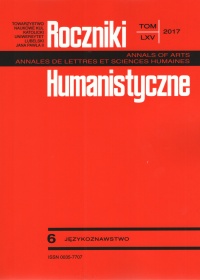Against a movement analysis of dać + się + infinitive structure in Polish
Abstrakt
Przeciwko opartej na przesunięciu analizie struktury dać + się + bezokolicznik w polszczyźnie
Autorka analizuje składnię struktury zawierającej dać + się + bezokolicznik w języku polskim. Od strony semantyki struktura ta obejmuje stwierdzenia generyczne, wyrażające modalne znaczenie zdolności. Ze składniowego punktu widzenia struktura ta ma uporządkowanie argumentów typowe dla strony biernej i zwrotnej, a mianowicie tematyczny argument wewnętrzny pojawia się w pozycji podmiotu. Ponieważ struktura zawierająca dać + się + bezokolicznik jest na powierzchni podobna do zdań w stronie biernej i zwrotnej, podjęto próbę sprawdzenia, czy można ją derywować za pomocą przesunięcia, tak jak to było często postulowane dla strony biernej i zwrotnej. Przedstawione są zwłaszcza argumenty za tym, że struktura zawierająca dać + się + bezokolicznik w polszczyźnie ma wiele wspólnych właściwości składniowych ze strukturą w stronie zwrotnej z czasownikiem lassen w języku niemieckim, która ostatnio była analizowana przez Piteroffa (2014) za pomocą przesunięcia. Autorka bada, czy derywacja opierająca się na przesunięciu ma rację bytu dla struktury zawierającej dać + się + bezokolicznik w polszczyźnie. Chociaż na pierwszy rzut oka atrakcyjny, po głębszej analizie okazuje się, że model Piteroffa nie ma zastosowania dla struktury analizowanej w artykule. W miejsce analizy opartej na przesunięciu autorka proponuje tezę, że podmiot jest generowany bazowo w zdaniu głównym i nie podlega przesunięciu do tej pozycji za pomocą przesunięcia żadnego typu.
Bibliografia
Ackema P., Schoorlemmer M.: Middles, in: The Blackwell companion to syntax, vol. III, eds. M. Everaert and H. van Riemsdijk, Oxford 2005, pp. 131-203.
Alexiadou A.: Non-canonical passives revisited: Parameters of non-active Voice, “Linguistics” 50(2012), pp. 1079-1110.
Alexiadou A., Anagnoustopoulou E., Schäfer F.: The properties of anticausatives cross-linguistically, in: Phases of interpretation, ed. M. Frascarelli, Berlin 2006, pp. 187-211.
Baker M.: Incorporation, Chicago 1988.
Baker M., Johnson K., Roberts I.: Passive arguments revisited, “Linguistic Inquiry” 20(1989), pp. 219-251.
Biały A.: Polish psychological verbs at the lexicon-syntax interface in cross-linguistic perspective, Ph.D. dissertation, Wrocław University 2004.
Bondaruk A.: A comparison of the modal dać się structure with the dispositional middle in Polish, “Linguistics Beyond and Within” 1(2015), pp. 43-63; http://lingbaw.com/volumes/2015/
Bondaruk A.: The modal dać się structure in Polish is syntactically causative, ms., John Paul II Catholic University of Lublin.
Chomsky N.: Lectures on government and binding, Dordrecht 1981.
Chomsky N.: Minimalist inquiries: The framework, in: Step by step, eds. R. Martin, D. Michaels and J. Uriagereka, Cambridge (MA) 2000, pp. 89-155.
Chomsky N.: Derivation by phase, in: Ken Hale. A life in language, ed. M. Kenstowicz, Cambridge (MA) 2001, pp. 1-52.
Chomsky N.: On phases, in: Foundational issues in linguistic theory. Essays in honor of Jean-Roger Vergnaud, eds. R. Freidin, C.P. Otero, M.L. Zubizarreta, Cambridge (MA) 2008, pp. 134-166.
Collins Ch.: A smuggling approach to the passive in English, “Syntax” 8(2005), pp. 81-120.
Embick D.: Localism versus globalism in morphology and phonology, Cambridge (MA) 2010.
Everaert M.: The Syntax of reflexivisation, Dordrecht 1986.
Fagan S.M.B.: The syntax and semantics of middle constructions: A study with special reference to German, Cambridge 1992.
Fanselow G.: Minimale Syntax, Groningen 1991.
Grewendorf G.: Refexivierung in deutschen A.c.i.-Konstruktionen. Kein transformationsgrammatisches Dilemma mehr, “Groninger Arbeiten zur germanistischen Linguistik“ 23(1983), pp.120-196.
Halle M., Marantz A.: Distributed morphology and the pieces of inflection, in: The view from building 20, eds. K. Hale and S. J. Keyser, Cambridge (MA) 1993, pp. 111-176.
Harley H., Noyer R.: State-of-the-article: Distributed Morphology, “Glot International” 4(1999), pp. 3-9.
Hoekstra T., Roberts I.: Middle constructions in Dutch and English, in: Knowledge and language II. Lexical and conceptual structure, eds. E. Reuland and W. Abraham, Dordrecht 1993, pp. 183-220.
Jaeggli O.: Passive, “Linguistic Inquiry” 17(1986), pp. 587-622.
Keyser S., Roeper T.: On the middle and ergative construction in English, “Linguistic Inquiry” 13(1984), pp. 381-416.
Kibort A.: Passive and passive-like constructions in English and Polish, Ph.D. dissertation, University of Cambridge 2004.
Klingvall E.: How to approach complex passives, in: Discourse and Grammar. A festschrift in honor of Valéria Molnar, eds. J. Brandtler, D. Håkansson, S. Huber and E. Klingvall, Lund 2012, pp. 395-410.
Krzek M.: The syntax of impersonal constructions in Polish, Ph.D. dissertation, University of Newcastle 2013.
Kunze J.: Plain middles and ‘lassen’ middles in German: Reflexive constructions and sentence perspective, “Linguistics” 34(1996), pp. 645-695.
Kupść A.: Haplology of the Polish reflexive marker, in: Slavic in Head-Driven Phrase Structure Grammar, eds. R. D. Borsley and A. Przepiórkowski, Stanford (CA) 1999, pp. 91-124.
Lekakou M.: In the middle, somewhat elevated. The semantics of middles and its crosslinguistic realization, Ph. D. dissertation, University of London 2005.
Marantz A.: No escape from syntax: Don’t try morphological analysis in the privacy of your own lexicon, “University of Pennsylvania Working Papers in Linguistics” 4(1997), pp. 201-225.
Marelj M.: Middles and argument structure across languages, Ph.D. dissertation, Utrecht Institute of Linguistics 2004.
Pitteroff M.: Non-canonical lassen-middles, Ph.D. dissertation, University of Stuttgart 2014.
Reis M.: Reflexivierung in deutschen A.c.I.-Konstruktionen. Ein Transformations-grammatisches Dilemma, “Papiere zur Linguistik” 9(1976), pp. 5-82.
Stroik T.: Middles and movement, “Linguistic Inquiry” 23(1992), pp. 127-137.
Topolińska Z.: The verb dać/ dawać in Polish periphrastic constructions, in: Studies in Polish morphology and syntax, eds. G. Henstchel and R. Laskowski, München 1993, pp. 229-249.
Vendler Z.: Linguistics in Philosophy, Ithaca 1967.
Waldenfels R. von: The grammaticalization of ‘give’ + infinitive. A comparative study of Russian, Polish, and Czech, Berlin 2012.
Copyright (c) 2017 Roczniki Humanistyczne

Utwór dostępny jest na licencji Creative Commons Uznanie autorstwa – Użycie niekomercyjne – Bez utworów zależnych 4.0 Międzynarodowe.





